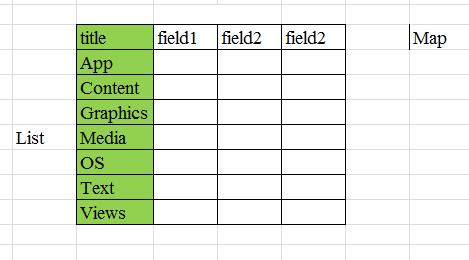如上一节中所讲的那样创建了ApiDemo工程后,我们就可以进行每个示例代码的分析了。读者应对Android开发有基本的了解或读过Android开发方面的基础教程。
首先是看ApiDemo的主Activity:com.example.android.apis.ApiDemos,这个主Activity为ListActivity的子类,主要用来列出ApiDemos中的200多个实例,实例采取分类层次显示。
在ApiDemos的onCreate()中的代码:
- setListAdapter(new SimpleAdapter(this, getData(path),
- android.R.layout.simple_list_item_1, new String[] { "title" },
- new int[] { android.R.id.text1 }));
SimpleAdatper 作为数据源 getData(path) 与 UI ListActivity 之间的桥梁,它的构造函数如下:
SimpleAdapter(Context context, List<? extends Map<String, ?>> data, int resource, String[] from, int[] to)
我们知道ListActivity可以用来显示一个列表,在使用SimpleAdapter时可以借用二维表来更好的理解。 SimpleAdapter的数据源data 类型为List<? extends Map<String, ?>> List 中每一项为一个Map对象,相当于二维表中一行,这一行可以有多列,每列可以有个名字,为Map<String,?> string ,相当于表的列名:

ApiDemos中每条记录只显示一列”title”。 android.R.layout.simple_list_item_1 为用来显示每条记录的Layout资源id, ListActivity允许使用自定义Layout ,这里使用了Android系统资源,simple_list_item_1由一个TextView构成,其id为text1。
new String[] { “title” } 为需要显示的列表的数组,ApiDemos只显示一列“title”,如果有多列:则可以为new String[] { “title”,”field1”,”field2”,”field3” }。
new int[] { android.R.id.text1 }则指定使用 android.R.layout.simple_list_item_1 中 id 为text1的 TextView 来显示 “title” 列。 如果有多列,Layout可以定义多个View (不一定都为TextView),然后为每列指定显示的View的id。
再来看看getData(path)是如何定义的,protected List getData(String prefix) 返回一个列表。
- protected List getData(String prefix) {
- List<Map> myData = new ArrayList<Map>();
- Intent mainIntent = new Intent(Intent.ACTION_MAIN, null);
- mainIntent.addCategory(Intent.CATEGORY_SAMPLE_CODE);
- PackageManager pm = getPackageManager();
- List<ResolveInfo> list = pm.queryIntentActivities(mainIntent, 0);
- ... ...
- for (int i = 0; i < len; i++) {
- ...
- if ((prefixPath != null ? prefixPath.length : 0) == labelPath.length - 1) {
- addItem(myData, nextLabel, activityIntent(
- info.activityInfo.applicationInfo.packageName,
- info.activityInfo.name));
- } else {
- if (entries.get(nextLabel) == null) {
- addItem(myData, nextLabel,
- browseIntent(prefix.equals("") ? nextLabel : prefix + "/" + nextLabel));
- entries.put(nextLabel, true);
- }
- }
- }
- }
- Collections.sort(myData, sDisplayNameComparator);
- return myData;
- }
它通过PackageManager 从 AndroidManifest.xml中读取所以Intent-Filter含有:Intent.ACTION_MAIN和 Intent.CATEGORY_SAMPLE_CODE所有Activity信息。前面说过200多个示例根据其功能分类,比如 Hello World示例它的Label为
App/Activity/<b>Hello <i>World</i></b>,
表示它的分类为分类App下Activity子类。getData(String prefix)根据每个Activity的Label属性和当前层次(prefix)来决定当前列表中某项为叶子列表项,还是分类列表项,如果是叶子列表 项,则添加为activityIntent,当用户点击改列表项时则会触发该示例。若是分类列表项,则添加为 browseIntent,browseIntent还是触发ApiDemos Activity,但Intent带有Extra信息,表示需要显示改分类下的子类:
- Intent result = new Intent();
- result.setClass(this, ApiDemos.class);
- result.putExtra("com.example.android.apis.Path", path);
此时如果用户点击改节点列表项,则会进入还分类下级目录。
- protected void addItem(List<Map> data, String name, Intent intent) {
- Map<String, Object> temp = new HashMap<String, Object>();
- temp.put("title", name);
- temp.put("intent", intent);
- data.add(temp);
- }
- @Override
- protected void onListItemClick(ListView l, View v, int position, long id) {
- Map map = (Map) l.getItemAtPosition(position);
- Intent intent = (Intent) map.get("intent");
- startActivity(intent);
- }
addItem 给返回的List中添加一项,每个记录含两列:“title”,“intent” ,其中只显示“title”列,如果想要显示“intent”列的信息,就不能使用 android.R.layout.simple_list_item_1 了,这时可以另外定义一个Layout 来显示多列数据。 intent可以为触发示例,如”Hello World”或是下级示例列表,此时触发的Activity还是ApiDemos。
此外,ApiDemo还定义了ApiDemosApplication做为Application的子类,如果需要在多个Activity共享一些数据, 可以定义在Application中。如果使用了自定义的Application,别忘了修改AndroidManifest.xml ,如下:
- <application android:name=”ApiDemosApplication”
- android:label=”@string/activity_sample_code”
- android:icon=”@drawable/app_sample_code” >
- …
- </application>
























